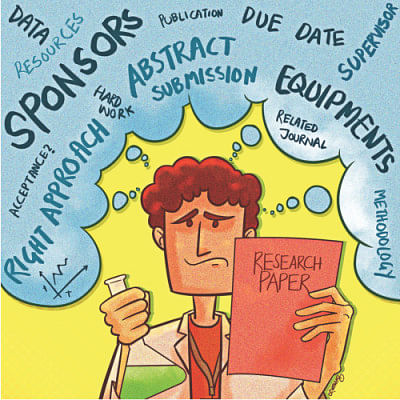RESEARCHING FOR ANSWERS

The thought of embarking on a journey towards innovation, discovery, and rediscovery is somewhat daunting. Interconnected to this is the idea that you will get out of your head and extend the boundaries of existing knowledge.
Not everyone is particularly interested in good old laboratory or fieldwork or doing research in general. But for those hoping to bring something novel through research, here’s a guide on how it works, where you might make mistakes, the current scenario of research in Bangladesh, and what the future holds for this substantial field.
KNOWING WHERE TO START
Start by brainstorming ideas for your research. Go for something unique, or bring something new to an existing research. If you are doing the latter, try to work on the limitations that the previous research had. Also, finalise the type of research and research methodology you are willing to work with.
Next, look for a supervisor to guide you through the process, and get yourself a team of dedicated people who are not only interested to get a paper published—if that is what you aim for—but have genuine care for the research itself. Run the initial idea through your supervisor(s) and your team, and together, check its feasibility. Factors such as budget, resources, data, etc. will influence the feasibility. You also need to have regular team meetings to finalise the topic and approach.

Once the topic is finalised, go through research papers and reading material that are directly or indirectly related to your topic. You can look for the papers on Google Scholar or your university repository. Use Google Dataset Search or Kaggle to find existing datasets.
The next step is to get the paper published. There are guidelines specified for each individual journal or conference, and sticking to these is top priority. Failing to comply will guarantee a rejection. For first timers, it is recommended they pick journals that are moderately ranked. There are tools like journal finders which intelligently suggest journals upon attaching the manuscript online.
“Research takes a lot of courage and patience,” says Md Sadman Siraj, a recent graduate from the Department of Electrical and Electronic Engineering, University of Dhaka. “Patience is imminent in research. Being courageous in the face of unprecedented challenges, lack of funds and resources, insufficient data, uncongenial lab environments, and peer pressure against such work can go a long way to chasing down this beautiful dream of fundamentally contributing to the ever growing and developing research community of the world.”
Sadman started university back in 2016, and by 2017, he had already published his first paper at an international conference hosted by the Institute of Electrical and Electronics Engineers (IEEE). Ever since, he has gone on to publish two more papers before even completing his graduation.
For Sadman and other young minds who are interested in this field, it has always been about passion and the desire to know. You might have zero to little idea as to how to work on such a paper, but with a bit of hard work, and proper guidance, you too can find your way in this field.

COMMON MISTAKES
Normally, a paper is structured in the IMRaD (Introduction, Method, Results and Discussion) format. Students must choose a striking yet appropriate title for the paper, provide relevant figures in suitable scales, draw logical conclusions from results, and clearly state the aim of the study.
Despite sounding straightforward, beginners often make mistakes here. It is not until they get to the proofreading stage that they become aware of these mistakes.
“At times, students focus on too many unnecessities while leaving out what is important,” says S M Rakib-uz-Zaman, lecturer at the Department of Mathematics and Natural Sciences, BRAC University. “A student should allocate a minimum period of two weeks for proofreading.”
Zaman also thinks that other members associated with the research must take part in this as well. This provides different perspectives on the paper and strengthens the outcome.
Proofreading also reveals technical errors. It is easy to work with things in the lab but when explaining certain aspects, which will vary from field to field, students fail to link or clarify happenings logically. It is also crucial that the ones writing the paper are fluent in English and have a firm grasp of grammar and the jargon.
Many students tend to slip away from the rules of citation and references. It is advised that they refresh their memories prior to writing as there is a margin of plagiarism to avoid.

THE RESEARCH SCENE IN BANGLADESH
To understand the research scenario in Bangladesh, we can take a look at the QS World University Rankings. More specifically, we need to look at the “citations per faculty” column. Citation per faculty is a measure used by QS ranking system to assess research output of different universities. The higher the score, the better the research output.
Universities at the top of the rankings like MIT, Harvard, and Stanford have a score of 99 on a scale of 100. The top three Asian universities in the rankings have an average citation per faculty score of 81.
The top two Bangladeshi universities in the rankings—the University of Dhaka (DU) and Bangladesh University of Engineering and Technology (BUET)—do not have a score for this measure in particular. However, their scores for citation per paper are also very low compared to other Asian universities, with DU having a score of 33.1 and BUET 19.2.
The UK Times Higher Education (THE) World University Rankings of 2020 gives the University of Dhaka a score of 8.8 out of 100 in research; this is one of the lowest scores on the list.
According to Scientific Bangladesh, Bangladeshi researchers have been affiliated with just over 6000 publications in the Scopus database in 2019. Although this number is slowly increasing, it is still a long way off compared to researchers from our neighbouring countries India and Pakistan, who have been affiliated with over 1,75,000 and 22,000 publications respectively.

WHY ARE WE LAGGING BEHIND?
Bangladesh lagging behind in research can be explained by a number of reasons, one of which is the lack of funding. Securing funds is a hassle. Most researchers are funded by either the government or the university they work for unlike abroad where there are plenty of private organisations offering generous grants.
“Due to such dearth, it is quite possible that a scientist is forced to drop an ambitious project,” comments Prof. M Mahboob Hossain of Department of Mathematics and Natural Sciences, BRAC University. “Renowned research organisations in the country have considerably better equipment than most universities as they are funded by the government.”
However, their academic output is still low. These resources are not being properly utilised and the scientists employed are not under pressure to perform better. Hence, there is a lack of accountability, which, despite having resources and funding, restricts the researchers from carrying out their work.
“Bangladesh still doesn’t have enough internal funding,” suggests Selima Sara Kabir, Research Assistant at BRAC James P Grant School of Public Health. “We’re still heavily reliant on international funding and grants. This means, sometimes, to be self-sufficient as a research space, we need to do projects that donors or funders want instead of what we might.”
Despite this, in Selima’s limited experience, she feels that they have managed to redirect the funding in a way to produce meaningful and relevant research.

THE FUTURE OF RESEARCH
“Our school is really welcoming of young minds,” says Selima. “Our Dean, Sabina F Rashid, makes sure that even young researchers aren’t bound by hierarchy and have a voice. I feel like in research, it’s nice because you need to be able to think critically and do the work. And if you’re willing to put in that effort, it pays off.”
Selima also suggests that in other work fields, you have to work from the ground up. However, in research, everyone is working at the grassroots level. Hence, there is a lot of scope for young minds to think and thrive.
“One should pursue their research work until they feel that they have done enough to contribute to the research community,” suggests Sadman. “This is a feeling one would get when someone’s research work has actually changed the way people think about that particular matter and have progressed the work of other research groups.”
Sadman also believes that what Bangladesh lacks in creating an overall research environment, it makes up for that by producing rigorously hardworking and immensely talented individuals every year.
“Do what you’re passionate about—be it study, research or any competition,” he adds. “One day, you will realise that learning for yourself will pave the way to your future rather than learning for exams.”
References
1. www.topuniversities.com/university-rankings/world-university-rankings/2019
2. https://scientificbangladesh.com/only-6000-scientific-documents-in-2019-in-the-scopus-database-with-bangladeshi-affiliation/ 3. https://www.timeshighereducation.com/world-university-rankings/2020/world-ranking#!/page/0/length/25/sort_by/scores_overall/sort_order/asc/cols/scores


 For all latest news, follow The Daily Star's Google News channel.
For all latest news, follow The Daily Star's Google News channel. 



Comments